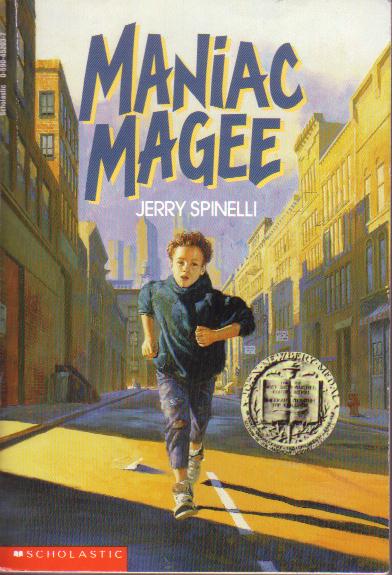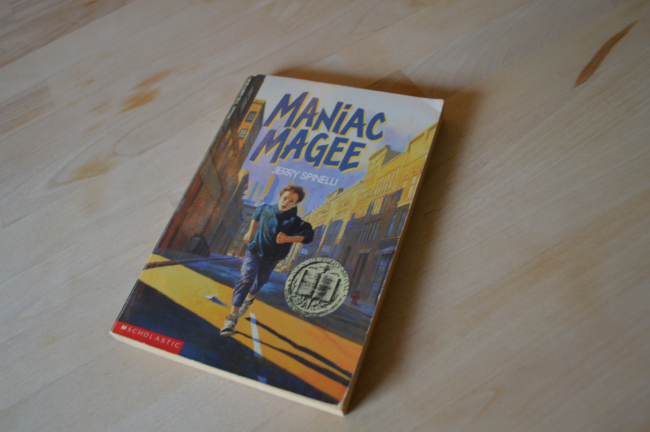
Maniac Magee by Jerry Spinelli (1991 Newbery winner) follows the crazy fast, incredibly athletic, kind, and lonely Jeffrey Lionel Magee. Magee runs into town, and outruns, out-catches, out-reads, and out-unentangles everyone in Two Mills. He was orphaned at a young age, taken in by two quarreling relatives and is in search of a family. He’s blind to the stark black-white divide between East-End and West-End in Two Mills. The Kirkus review described it as a “parable-like story about racism and ignorance” and I think that captures the tone and substance of this novel succinctly.

What I liked. There were so many surprising relationships and observations throughout the book. I loved the description of Magee’s very early morning runs, where he gets to know everyone by their backyards: “Flowers, weeds, junk, pet houses, tree houses, vegetable gardens, rubber tired, grass ranging from desert-sparse to shaggy to trim as a marine’s haircut–the back yards were as different, as individual as faces” (p. 168). I feel a bit like this as I walk along our daily neighborhood route, that I too have gotten to know the houses just by their yards.
One of my other favorite descriptions of the book is when Magee teaches the old semi-pro pitcher, Earl Grayson, how to read. My dyslexia makes vowels so slippery, so I completely relate to this description of vowels”
“Vowels were something else. He [Earl Grayson] didn’t like them, and they didn’t like him. There were only five of them, but they seemed to be everywhere. Why you could go through twenty words without bumping into some of the shyer consonants, but it seemed as if you couldn’t tiptoe past a syllable without waking up a vowel. Consonants, you knew pretty much where they stood, but you could never trust a vowel. To the old pitcher, they were like his own best knuckle ball come back to haunt him. In, out, up, down –not even the pitcher, much much less the batter, knew which way it would break. He kept swinging and missing. “
p. 101

What was interesting. There were so many different families that Magee encountered–from the buffalo at the zoo, the warm and wonderful Beals, the crazy McNabs, his terrible aunt and uncle, the generous Pickwells, kind Earl Grayson, and surprisingly kind Mars Bars Thompson and his mother. The setting and tone for each of these was incredibly different, especially the racist McNab family, that you never knew what the next chapter was going to be about.

What were some limitations / What it teaches me as a writer. I think this is a really well done book, so there isn’t much that I would say is a limitation. At the very end of the book there is an important moment when Magee won’t cross a train trestle. Now, there are a number of times that people do pretty jarring and unexpected things in the book, so while I was a little confused, it didn’t seem completely out of step with the rest of the book.
But after a few paragraphs there is a reminder that his parents died in a train accident when a trestle collapsed, hence why the nearly fearless Magee wouldn’t cross one. I think the ending would have been stronger if one or two times the train trestle issue had come back up in the middle of the book. Then the reader would have been able to spot right away what the trestle signified.
I’m fascinated by what makes endings to books feel really satisfying. I think that a combination of something that the audience doesn’t expect but then immediately recalls and connects with is one ingredient.
For me, another element of a strong ending is the redemption of a character. Tough Black Mars Bar Thompson saving the two crazy young white McNab brothers off the train trestle has many layers of redemption to it. Mars Bar Thompson starts out as such an antagonist to Magee, driving him from the black side of town and the Beal family, so the friendship that grows between Mars Bar and Magee by the end makes the ending so strong and a symbol of hope.

Similarity to other Newbery winners. The narrative voice in this book is so unique, but it reminds me a little of It’s Like This–Cat with its urban setting and a boy coming of age as he wanders about the city. The many characters and families and hyperbolic accomplishments remind me a little of The Westing Game and From the Mixed-Up Files of Mrs. Basil E. Frankweiler. In terms of its themes of race, it reminds me of Roll of Thunder Hear My Cry, I, Juan de Pareja, and Sounder.
Have you read Maniac Magee? What are your favorite books that address racial disparities and segregation for kids?
*Note* This post contains Amazon affiliate links, which means if you were to buy a book, I’d get a tiny commission at no cost to you. Thanks for supporting Stories & Thyme!*
